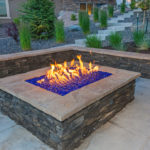Having a bird bath in your backyard is a great way to attract birds and other wildlife to your home – alongside adding a lovely water feature and focal point. But how do you know which one you should go for – and once installed, how do you look after your bird bath? This article will help you design which bird bath designs to go for, and how to look after them!
Types of Bird Baths
There are a huge variety of bird baths available on the market – and a big factor on which one to pick will depend on your budget and personal style. The main types of bird baths are as follows:
- Ground: A ground bird bath is the most simplest of styles – it is essentially a basin that lies on the ground. These are relatively easy and cheap to make – even an old pie dish would suffice! These type of baths are particularly good if you wish to attract ground birds, such as ducks.
- Pedestal: The same as a ground bird bath, but it is elevated on a pedestal. These tend to be the most popular option and therefore, can be bought in a wide variety of designs and styles to suit most tastes.
- Hanging: This is essentially a basin that is suspended by a chain – it can be hung from a tree, hook or any other feature within your yard.
- Fountain: As the name suggests, these bird baths having running water as a feature. The noise and movement of the water means these are particularly great at attracting birds – but can be more on the pricey side.
- Heated: This is a good choice if you live in a cooler climate as it prevents your bird bath from freezing during the Winter months.
- Solar: This is either a fountain or heated bird bath that relies on solar power to warm or create movement to the water. These are initially quite expensive to buy, but are a long-term cost-effective option if you want this type of feature in your yard.
Selecting the Best Bird Bath
The ultimate deciding factor on which bird bath to pick will depend on your style and budget. If you wish to create a feature – then you can opt for a pedestal or hanging bird bath. You can take it a step further and have your bird bath as a fountain – attracting more birds and creating tranquil movement and noise in your back yard; however, this will come at a cost.
The type of surrounding wildlife in your area will also dictate which bird bath you should get. If you know that you have a lot of ground bird nearby – such as quails and ducks – then a ground bird bath would be best suited for these.
Figure out your budget, style, and surrounding wildlife and then choose the bird bath to suit these needs.
Creative DIY Ideas
Home depots stores up and down the country will have a plethora of wonderful bird baths for sale; however, you can save money by making your own unique feature!
Just about any basin-type container can serve as a bird bath. Have a look around your garage or kitchen and see what you can reinvent as a bath for your feathered wildlife.
You could try using different planters and rearrange them to create a unique display. Almost any container can be used for a a bird bath – even an old teapot. You can jazz up your DIY bird bath with colorful pebbles, paint, gravel, or even shells.
Using natural items – such as stones or pebbles are a great idea as they won’t deter or harm the wildlife whilst making your bird bath more aesthetically pleasing. When rejuvenating old objects, adding a lick of color can transform your old crockery pot into a striking feature. You must make sure when making your own bird baths, that the objects and paint you use is safe for birds.
When painting the exterior, you can use an oil-based, latex, or acrylic paint; however, it is worth nothing that only latex and acrylic paints are safe for use on the inside of the basin once they are dried.
How to Look After Your Bird Bath
Make sure you regularly remove any old or stagnant water from your bird bath. When you remove the old water, take out any deposits of seeds, debris, or leaves. If you want to clean your bird bath then you can use a solution of one part distilled white vinegar to nine parts water and give the container a good scrub with a cloth – make sure you don’t use any chemicals as these could cause harm to the wildlife.
Interested in more ideas about adding decorative water elements to your yard or garden?
See more outdoor living and gardening articles.






